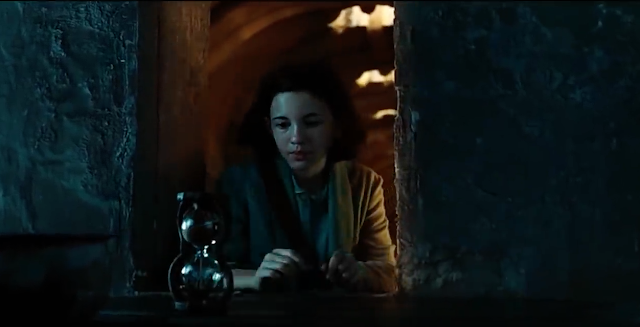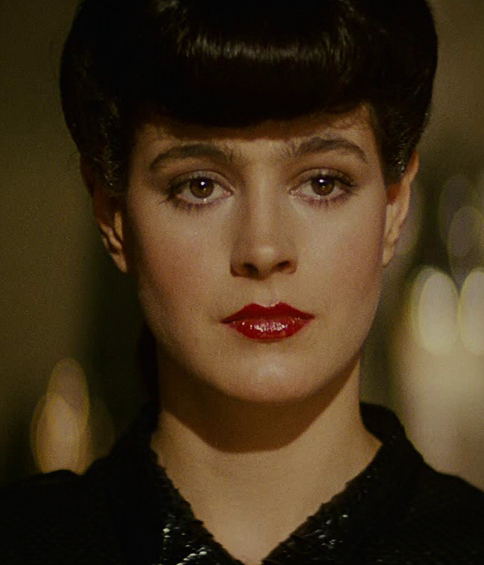kill bill vol 2, wedding scene
Tarantino begins his scene with a tracking mid-shot, in this shot he also uses the rule of three to show that there is an absence of people on the bride's side of the church. This shot could also symbolise the whole message of the scene, by the guests on the grooms side representing her potential future and the empty pews; her dark and friendless past. Thurman is in the middle third of the shot (rule of three) and is walking down the aisle. this could be seen as her walking the line between her past and her future. Something the whole scene is about, whether she will be able to start a new life or will her past always catch up with her.
This then transforms into a shot reverse shot when Thurman hears the diegetic flute playing from Carradine. This shows that before the character is seen we, the audience knows that The Bride recognises who the mysterious figure is and that they mean something to her because she looks to find him, then on not being able to see Bill she checks to see if her husband is there before a mid tracking shot sees her walk towards the music. During this sequence a non diegetic soundtrack is played starting from after The Bride hears the flute the first time. I think that this shows the contrast between the lack of her past and then the sudden appearance of a familiar if unsavoury person. The next shot shows Thurman walking tho the door, It begins as a mid-shot which becomes a mid-long shot as The Bride walks closer to the light and finally becomes and long shot as she leans against a wooden beam. Throughout the scene we witness the sharp juxtaposition of the dark mise-en-scene of the chapel wall against the bright light outdoors. This could symbolise the wedding ceremony that is about to take place as she has the potential to leave her dark past behind her and to start a new bright future.This then quickly cuts to a two mid shot from a low angle with The Bride slightly out of focus and with her back facing Bill.
The distance shown by the lack of dialogue and Thurman's back is stressed by the actual space between the two characters. This is obviously showing that The Bride is now very different to her past. This juxtaposition of future and past is again portrayed by the theme of light versus darkness. In this scene it is made clear by the different character's clothing. Bill is wearing black and The Bride is in white. His clothing is by far the darkest mise-en-scene in the shot which is also a contrast to the other mise-en-scene which appears to be a drab waste land. This conveys the mixed emotions that The Bride must be feeling to be in the presence of Bill again; She feels both anxious that her past has found her but relieved for something more exciting has come along.
This then transforms into a shot reverse shot when Thurman hears the diegetic flute playing from Carradine. This shows that before the character is seen we, the audience knows that The Bride recognises who the mysterious figure is and that they mean something to her because she looks to find him, then on not being able to see Bill she checks to see if her husband is there before a mid tracking shot sees her walk towards the music. During this sequence a non diegetic soundtrack is played starting from after The Bride hears the flute the first time. I think that this shows the contrast between the lack of her past and then the sudden appearance of a familiar if unsavoury person. The next shot shows Thurman walking tho the door, It begins as a mid-shot which becomes a mid-long shot as The Bride walks closer to the light and finally becomes and long shot as she leans against a wooden beam. Throughout the scene we witness the sharp juxtaposition of the dark mise-en-scene of the chapel wall against the bright light outdoors. This could symbolise the wedding ceremony that is about to take place as she has the potential to leave her dark past behind her and to start a new bright future.This then quickly cuts to a two mid shot from a low angle with The Bride slightly out of focus and with her back facing Bill.
The distance shown by the lack of dialogue and Thurman's back is stressed by the actual space between the two characters. This is obviously showing that The Bride is now very different to her past. This juxtaposition of future and past is again portrayed by the theme of light versus darkness. In this scene it is made clear by the different character's clothing. Bill is wearing black and The Bride is in white. His clothing is by far the darkest mise-en-scene in the shot which is also a contrast to the other mise-en-scene which appears to be a drab waste land. This conveys the mixed emotions that The Bride must be feeling to be in the presence of Bill again; She feels both anxious that her past has found her but relieved for something more exciting has come along.





Comments
Post a Comment